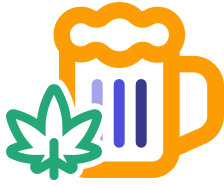Creating a Drug and Alcohol policy
Employees expect you to have a policy related to drugs and alcohol, but it needs to be more than the mere dos and don’ts. With increased awareness surrounding substance use and misuse, it’s important to provide a policy that goes well beyond the punishment piece. If your employees are struggling, the best thing you can do is provide them with the resources to recover. Though employees won’t be surprised to see a drug and alcohol policy in your handbook, it’s still important to define why the policy exists and how you may be able to help employees in need.
Key points to include
When developing your drug and alcohol policy, you must cover certain elements. These items include the policy basics, such as:
- Reference to the Drug-Free Workplace Act of 1988, if applicable
- Rules prohibiting the use, possession, solicitation for, or sale of alcohol, drugs, or related paraphernalia on company property (consider defining “company property”)
- Zero tolerance for working under the influence
- Policies / procedures related to prescription medications
- Testing policies (e.g., pre-employment, post-accident, reasonable suspicion, random)
- Consequences, including possible criminal enforcement
In addition to the compulsory items above, you should maintain an employee-first focus by covering the following:
- Resources for employees seeking treatment
- Leave options related to rehabilitation
- Prioritization of health, safety, and security at work, including while driving
- Relevant links such as https://www.samhsa.gov/find-help/national-helpline
This policy might be longer than most, but there are many factors to consider when creating a policy related to drugs and alcohol. Read more policy guidance offered by the Substance Abuse and Mental Health Services Administration.
Why it matters
As long as your policy promotes workplace safety and employee well-being above all, most employees will understand the need for it. However, it’s still important that you articulate the rationale behind your policies and procedures so employees don’t think you’re just being authoritative because you can. Before you get into the nuts and bolts of your policy, START the policy with the why behind it.
The intro to your drug and alcohol policy may go a little something like this:
We prioritize workplace safety and employee well-being. In an effort to create the optimal working environment, we maintain a drug and alcohol free workplace. This policy outlines our expectations and, more importantly, offers information to help employees who are struggling with substance misuse.
What’s trending
Keep in mind that your drug and alcohol policy may also need to include specific information based on geography. For example, does your company operate in states where recreational marijuana use is legal? What about legality for medical purposes? At the time of this post, 18 states have legalized recreational cannabis use, and 37 states allow medical cannabis use. The landscape continues to evolve, so it’s imperative that you keep up with the latest laws and the most recent court cases. The National Conference of State Legislatures provides a useful resource highlighting the marijuana laws by state.
In addition to location-based regulations, federal rules require substance testing — including for marijuana usage for certain types of employees, like truck drivers for instance. Drug use policies must be enforced for certain employers, such as federal agencies and companies with federal contracts and grants.
Simply put, your drug and alcohol policy should be reviewed regularly to ensure it remains up to date.
Additional notes
Link to relevant handbook policies, such as:
- Workplace Safety
- Employee Resource Program
- Leaves of Absence
- Open Door Policy
While you’re perfecting your handbook, check out some other Blissbook content focused on policy creation:
